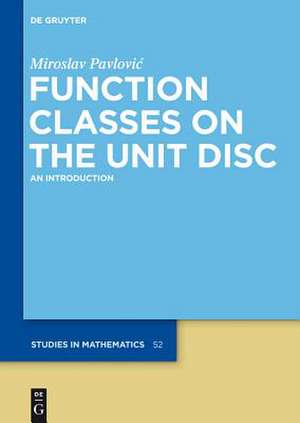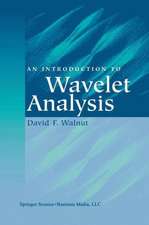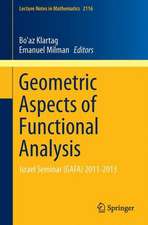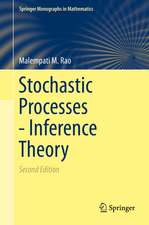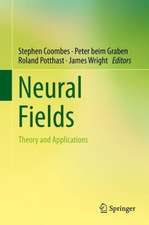Function Classes on the Unit Disc: An Introduction: de Gruyter Studies in Mathematics, cartea 52
Autor Miroslav Pavlovicen Limba Engleză Hardback – 31 dec 2013
Din seria de Gruyter Studies in Mathematics
- 23%
 Preț: 823.68 lei
Preț: 823.68 lei - 23%
 Preț: 891.91 lei
Preț: 891.91 lei - 23%
 Preț: 811.37 lei
Preț: 811.37 lei - 23%
 Preț: 1237.99 lei
Preț: 1237.99 lei - 23%
 Preț: 1077.81 lei
Preț: 1077.81 lei - 23%
 Preț: 1003.30 lei
Preț: 1003.30 lei - 23%
 Preț: 1316.68 lei
Preț: 1316.68 lei - 23%
 Preț: 1089.25 lei
Preț: 1089.25 lei - 23%
 Preț: 870.23 lei
Preț: 870.23 lei - 23%
 Preț: 1235.03 lei
Preț: 1235.03 lei - 23%
 Preț: 850.40 lei
Preț: 850.40 lei - 23%
 Preț: 1620.36 lei
Preț: 1620.36 lei - 23%
 Preț: 1652.24 lei
Preț: 1652.24 lei - 23%
 Preț: 1321.85 lei
Preț: 1321.85 lei - 23%
 Preț: 1618.89 lei
Preț: 1618.89 lei - 23%
 Preț: 1152.21 lei
Preț: 1152.21 lei - 23%
 Preț: 1390.60 lei
Preț: 1390.60 lei - 23%
 Preț: 1002.76 lei
Preț: 1002.76 lei - 23%
 Preț: 1235.33 lei
Preț: 1235.33 lei - 23%
 Preț: 707.13 lei
Preț: 707.13 lei - 23%
 Preț: 875.35 lei
Preț: 875.35 lei - 23%
 Preț: 1428.17 lei
Preț: 1428.17 lei - 23%
 Preț: 1086.71 lei
Preț: 1086.71 lei - 23%
 Preț: 1084.64 lei
Preț: 1084.64 lei - 23%
 Preț: 1542.79 lei
Preț: 1542.79 lei - 23%
 Preț: 1325.70 lei
Preț: 1325.70 lei - 23%
 Preț: 1652.82 lei
Preț: 1652.82 lei - 9%
 Preț: 797.25 lei
Preț: 797.25 lei - 23%
 Preț: 1028.06 lei
Preț: 1028.06 lei - 23%
 Preț: 1558.33 lei
Preț: 1558.33 lei - 23%
 Preț: 924.20 lei
Preț: 924.20 lei - 9%
 Preț: 737.32 lei
Preț: 737.32 lei - 23%
 Preț: 1436.34 lei
Preț: 1436.34 lei - 23%
 Preț: 1766.85 lei
Preț: 1766.85 lei - 23%
 Preț: 1163.61 lei
Preț: 1163.61 lei - 23%
 Preț: 1430.85 lei
Preț: 1430.85 lei - 9%
 Preț: 880.92 lei
Preț: 880.92 lei - 23%
 Preț: 1651.19 lei
Preț: 1651.19 lei - 9%
 Preț: 793.36 lei
Preț: 793.36 lei - 9%
 Preț: 795.34 lei
Preț: 795.34 lei - 23%
 Preț: 986.69 lei
Preț: 986.69 lei - 9%
 Preț: 795.59 lei
Preț: 795.59 lei - 23%
 Preț: 1274.40 lei
Preț: 1274.40 lei - 9%
 Preț: 922.89 lei
Preț: 922.89 lei - 23%
 Preț: 1269.92 lei
Preț: 1269.92 lei - 8%
 Preț: 555.75 lei
Preț: 555.75 lei - 9%
 Preț: 939.42 lei
Preț: 939.42 lei
Preț: 882.57 lei
Preț vechi: 969.85 lei
-9% Nou
Puncte Express: 1324
Preț estimativ în valută:
168.90€ • 176.11$ • 140.37£
168.90€ • 176.11$ • 140.37£
Carte tipărită la comandă
Livrare economică 17-24 martie
Preluare comenzi: 021 569.72.76
Specificații
ISBN-13: 9783110281231
ISBN-10: 3110281236
Pagini: 462
Dimensiuni: 170 x 240 x 30 mm
Greutate: 0.93 kg
Editura: De Gruyter
Colecția De Gruyter
Seria de Gruyter Studies in Mathematics
Locul publicării:Berlin/Boston
ISBN-10: 3110281236
Pagini: 462
Dimensiuni: 170 x 240 x 30 mm
Greutate: 0.93 kg
Editura: De Gruyter
Colecția De Gruyter
Seria de Gruyter Studies in Mathematics
Locul publicării:Berlin/Boston
Notă biografică
Miroslav Pavlovi?, University of Belgrade, Serbia.
Cuprins
Preface 1 Quasi-Banach spaces 1.1 Quasinorm and p-norm 1.2 Linear operators 1.3 The closed graph theorem The open mapping theorem The uniform boundedness principle The closed graph theorem 1.4 F-spaces 1.5 The spaces lp 1.6 Spaces of analytic functions 1.7 The Abel dual of a space of analytic functions 1.7a Homogeneous spaces 2 Interpolation and maximal functions 2.1 The Riesz/Thorin theorem 2.2 Weak Lp-spaces and Marcinkiewicz¿s theorem 2.3 The maximal function and Lebesgue points 2.4 The Rademacher functions and Khintchine¿s inequality 2.5 Nikishin¿s theorem 2.6 Nikishin and Stein¿s theorem 2.7 Banach¿s principle, the theorem on a.e. convergence, and Sawier¿s theorems 2.8 Addendum: Vector-valued maximal theorem 3 Poisson integral 3.1 Harmonic functions 3.1a Green¿s formulas 3.1b The Poisson integral 3.2 Borel measures and the space h1 3.3 Positive harmonic functions 3.4 Radial and non-tangential limits of the Poisson integral 3.4a Convolution of harmonic functions 3.5 The spaces hp and Lp(T) 3.6 A theorem of Littlewood and Paley 3.7 Harmonic Schwarz lemma 4 Subharmonic functions 4.1 Basic properties 4.1a The maximum principle 4.1b Approximation by smooth functions 4.2 Properties of the mean values 4.3 Integral means of univalent functions Prawitz¿ theorem Distortion theorems 4.4 The subordination principle 4.5 The Riesz measure Green¿s formula The Riesz measure of | f |p (f ¿ H(D)) and | u |p (u ¿ hp) 5 Classical Hardy spaces 5.1 Basic properties The decomposition lemma of Hardy and Littlewood 5.1a Radial limits The Poisson integral of log | f* | 5.2 The space H1 5.3 Blaschke products Riesz¿ factorization theorem 5.4 Some inequalities 5.5 Inner and outer functions 5.5a Beurling¿s approximation theorem 5.6 Composition with inner functions. Stephenson¿s theorems 5.6a Approximation by inner functions 6 Conjugate functions 6.1 Harmonic conjugates 6.1a The Privalov/Plessner theorem and the Hilbert operator 6.2 Riesz projection theorem 6.2a The Hardy/Stein identity 6.2b Proof of Riesz¿ theorems 6.3 Applications of the projection theorem 6.4 Aleksandrov¿s theorem: Lp(T) = Hp(T) + \overline{Hp}(T) 6.5 Strong convergence in H1 6.6 Quasiconformal harmonic homeomorphisms and the Hilbert transformation 7 Maximal functions, interpolation, and coefficients 7.1 Maximal theorems 7.1a Hardy/Littlewood/Sobolev theorem 7.2 Maximal characterization of Hp (Burkholder, Gundy and Silverstein) 7.3 ¿Smooth¿ Cesàro means ¿¿-maximal theorem The ¿W-maximal¿ theorem 7.4 Interpolation of operators on Hardy spaces 7.4a Application to Taylor coefficients and mean growth 7.4b On the Hardy/Littlewood inequality 7.4c The case of monotone coefficients 7.5 Lacunary series 7.6 A proof of the ¿¿-maximal theorem 8 Bergman spaces: Atomic decomposition 8.1 Bergman spaces 8.2 Reproducing kernels 8.3 The Coifman/Rochberg theorem q-envelops of Hardy spaces 8.4 Coefficients of vector-valued functions. Kalton¿s theorems 8.4a Inequalities for a Hadamard product 8.4b Applications to spaces of scalar valued functions 9 Lipschitz spaces 9.1 Lipschitz spaces of first order 9.2 Conjugate functions 9.3 Lipschitz condition for the modulus. Dyakonov¿s theorems with simple proofs by Pavlovic 9.4 Lipschitz spaces of higher order 9.5 Lipschitz spaces as duals of Hp, p < 1 10 Generalized Bergman spaces and Besov spaces 10.1 Decomposition of mixed norm spaces: case 1 < p < ¿ 10.1a Besov spaces 10.2 Decomposition of mixed norm spaces: case 0 < p ¿ ¿ 10.2a Radial limits of Hardy/Bloch functions 10.2b Fractional integration and differentiation 10.3 Möbius invariant Besov spaces 10.4 Mean Lipschitz spaces 10.4a Lacunary series in mixed norm spaces 10.5 Duality in the case 0 < p ¿ ¿ 10.6 Appendix: Characterizations of Besov spaces 11 BMOA, Bloch space 11.1 The dual of H1 and the Carleson measures Proof of Fefferman¿s theorem 11.2 Vanishing mean osillation 11.3 BMOA and mean Lipschitz spaces 11.4 Coefficients of BMOA-functions 11.4a Lacunary series 11.5 The Bloch space 11.5a On the predual of B Functions with decreasing coefficients 12 Subharmonic behavior 12.1 Subharmonic behavior and Bergman spaces Two simple proofs of Hardy/Littlewood/Fefferman/Stein theorem 12.2 The space hp, p < 1 Two open problems posed by Hardy and Littlewood 12.3 Subharmonic behavior of smooth functions 12.3a Quasi-nearly subharmonic functions 12.3b Regularly oscillating functions 12.4 A generalization of the Littlewood/Paley theorem 12.4a Invariant Besov spaces and the derivatives of the integral means 12.4b Addendum: The case of vector valued functions 12.5 Mixed norm spaces of harmonic functions 13 Littlewood/Paley theory 13.1 Some more vector maximal functions 13.2 The Littlewood/Paley g-function Calderon¿s generalization of the area theorem (p > 0) A proof of a the Littlewood/Paley g-theorem (p > 0) 13.3 Applications of Cesàro means 13.4 The Littlewood/Paley g-theorem in a generalized form An improvement 13.5 Proof of Calderon¿s theorem 14 Tauberian theorems and lacunary series on the interval (0,1) 14.1 Karamatäs theorem and Littlewood¿s theorem 14.1a Tauberian nature of ¿p1/p 14.2 Lacunary series in C[0,1] 14.2a Lacunary series on weighted L¿-spaces 14.3 Lp-integrability of lacunary series on (0,1) 14.3a Some consequences Bibliography
